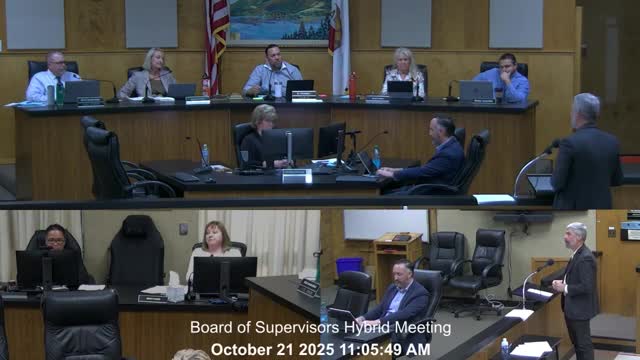Experts warn Mediterranean oak borer is spreading in Lake County; research, contractor training planned
October 23, 2025 | Lake County, California
This article was created by AI summarizing key points discussed. AI makes mistakes, so for full details and context, please refer to the video of the full meeting. Please report any errors so we can fix them. Report an error »

County and state entomologists and university advisers updated the Board of Supervisors on Oct. 21 about the spread of the Mediterranean oak borer (MOB) and described steps to detect and limit the pest’s spread.
Curtis Ewing of CAL FIRE and Michael Jones of UC Cooperative Extension said the beetle is now recorded across several California counties and that dispersal begins in spring when sapwood temperatures trigger adult flight. The insect introduces a black fungus into oak sapwood that can rapidly kill trees, the panel said.
Local biologists reported a surge of public reports and mapped sightings concentrated in residential zones and riparian corridors along the lake and creeks. “We’ve seen large chunks of lower branches dying off and entire trees turning brown at once,” said Julia Clickard of the Clear Lake Environmental Research Center.
County and university researchers are organizing contractor trainings for early detection and safe handling of infested wood, and several trials of chemical trunk injections and other treatments are planned for 2026, speakers said. Experts cautioned that pesticide injections are costly, require repeat application and are not a landscape‑scale cure; burial or controlled disposal of infested wood limits spread. County and tribal partners are also adding public reporting tools and iNaturalist projects for citizen scientists to submit sightings.
Ending: County officials urged residents not to move firewood, to report suspicious oak decline and to attend upcoming contractor and community trainings; they said more funding and multiagency coordination will be needed to slow the pest’s spread.
Curtis Ewing of CAL FIRE and Michael Jones of UC Cooperative Extension said the beetle is now recorded across several California counties and that dispersal begins in spring when sapwood temperatures trigger adult flight. The insect introduces a black fungus into oak sapwood that can rapidly kill trees, the panel said.
Local biologists reported a surge of public reports and mapped sightings concentrated in residential zones and riparian corridors along the lake and creeks. “We’ve seen large chunks of lower branches dying off and entire trees turning brown at once,” said Julia Clickard of the Clear Lake Environmental Research Center.
County and university researchers are organizing contractor trainings for early detection and safe handling of infested wood, and several trials of chemical trunk injections and other treatments are planned for 2026, speakers said. Experts cautioned that pesticide injections are costly, require repeat application and are not a landscape‑scale cure; burial or controlled disposal of infested wood limits spread. County and tribal partners are also adding public reporting tools and iNaturalist projects for citizen scientists to submit sightings.
Ending: County officials urged residents not to move firewood, to report suspicious oak decline and to attend upcoming contractor and community trainings; they said more funding and multiagency coordination will be needed to slow the pest’s spread.
View the Full Meeting & All Its Details
This article offers just a summary. Unlock complete video, transcripts, and insights as a Founder Member.
✓
Watch full, unedited meeting videos
✓
Search every word spoken in unlimited transcripts
✓
AI summaries & real-time alerts (all government levels)
✓
Permanent access to expanding government content
30-day money-back guarantee

